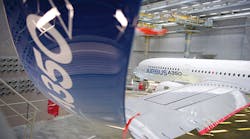The wings of the Airbus A350-1000 wide-body jet are now in assembly at the OEM’s production line in Broughton, Wales. At nearly 105 feet long and 20 feet wide (32 m X 6 m), they represent the largest single structure built of carbon-fiber composite material in use in civil aerospace.
The wings are designed and developed at Airbus’ aircraft in Filton, England, where a number of other systems are conceived and tested.
The A350 XWB wings are designed to give the aircraft less air resistance, for more speed, greater fuel efficiency, and less noise. Among the streamlined features are “droop-nose” leading edges and a new, adaptive dropped-hinge flaps, which increases aircraft fuel efficiency at low speeds.
The A350-1000 is the largest of three models for the A350-XWB, the twin-engine, wide-body aircraft developed as Airbus’s new long-range passenger jet option, an alternative to Boeing’s 787 Dreamliner. It will be the largest variant of the A350 series, seating 350 passengers in a three-class, two-aisle arrangement.
Airbus has nearly 170 orders for the A350-1000. Qatar Airways — which launched the first A350-XWB late last year — will be the launch customer for the larger jet in 2017.










